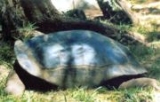
Arnold's Giant Tortoise
Encyclopedia
Arnold's giant tortoise (Aldabrachelys arnoldi), also known as the Seychelles saddle-backed tortoise, inhabited the granitic Seychelles
islands until around 1840, when it was presumed to be extinct, along with the Seychelles giant tortoise
; a species which shared the same islands.
The report of oddly-shaped of tortoises in captivity in the mid-1990s prompted the Nature Protection Trust of Seychelles to investigate the identity of these captive tortoises. Examination of museum specimens of the 'extinct' Seychelles and Arnold species seemed to confirm some living tortoises do show characteristics of the supposedly extinct species. However, some recently published scientific papers on the genetics of the Seychelles and Indian Ocean tortoises provide conflicting results. Some studies suggest only one species was ever present in the islands, whilst others suggest three distinct, but closely related species.
These different views derive from studies of different genes. A synthesis of all available genetic data indicates Arnold's tortoise is genetically the most distinctive Dipsochelys tortoise. This fits with the ecology and morphology of the species, as a highly distinctive tortoise adapted to feeding on low vegetation rather than the grazing habits of the Seychelles giant tortoise
and Aldabra giant tortoise
. Due to its unusual 'saddlebacked' shape, this is the only Seychelles tortoise species that regularly basks in the sun. The other species will do so occasionally, but Arnold's tortoises rapidly lose heat from the skin of their exposed necks and need to heat up in the sun in the mornings.
A captive breeding program was established in 1997, and in December 2006, the five adult tortoises were returned to the wild on Silhouette Island
, forming the first wild population of this species since the early 19th century.
Seychelles
Seychelles , officially the Republic of Seychelles , is an island country spanning an archipelago of 115 islands in the Indian Ocean, some east of mainland Africa, northeast of the island of Madagascar....
islands until around 1840, when it was presumed to be extinct, along with the Seychelles giant tortoise
Seychelles giant tortoise
The Seychelles giant tortoise has been thought to be extinct since the mid-19th century due to overexploitation on the granitic Seychelles islands. Similar giant tortoise species on other Indian Ocean islands such as Mauritius, Réunion and Rodrigues Island are also extinct...
; a species which shared the same islands.
The report of oddly-shaped of tortoises in captivity in the mid-1990s prompted the Nature Protection Trust of Seychelles to investigate the identity of these captive tortoises. Examination of museum specimens of the 'extinct' Seychelles and Arnold species seemed to confirm some living tortoises do show characteristics of the supposedly extinct species. However, some recently published scientific papers on the genetics of the Seychelles and Indian Ocean tortoises provide conflicting results. Some studies suggest only one species was ever present in the islands, whilst others suggest three distinct, but closely related species.
These different views derive from studies of different genes. A synthesis of all available genetic data indicates Arnold's tortoise is genetically the most distinctive Dipsochelys tortoise. This fits with the ecology and morphology of the species, as a highly distinctive tortoise adapted to feeding on low vegetation rather than the grazing habits of the Seychelles giant tortoise
Seychelles giant tortoise
The Seychelles giant tortoise has been thought to be extinct since the mid-19th century due to overexploitation on the granitic Seychelles islands. Similar giant tortoise species on other Indian Ocean islands such as Mauritius, Réunion and Rodrigues Island are also extinct...
and Aldabra giant tortoise
Aldabra Giant Tortoise
The Aldabra giant tortoise , from the islands of the Aldabra Atoll in the Seychelles, is one of the largest tortoises in the world....
. Due to its unusual 'saddlebacked' shape, this is the only Seychelles tortoise species that regularly basks in the sun. The other species will do so occasionally, but Arnold's tortoises rapidly lose heat from the skin of their exposed necks and need to heat up in the sun in the mornings.
A captive breeding program was established in 1997, and in December 2006, the five adult tortoises were returned to the wild on Silhouette Island
Silhouette Island
Silhouette Island lies 20 km northwest of Mahé in the Seychelles. It is the third largest island in the Seychelles. It has an area of 20 km² and has a population of 135, mostly workers on the island. The main settlement is La Passe, where there is a hotel for visitors to Silhouette...
, forming the first wild population of this species since the early 19th century.

